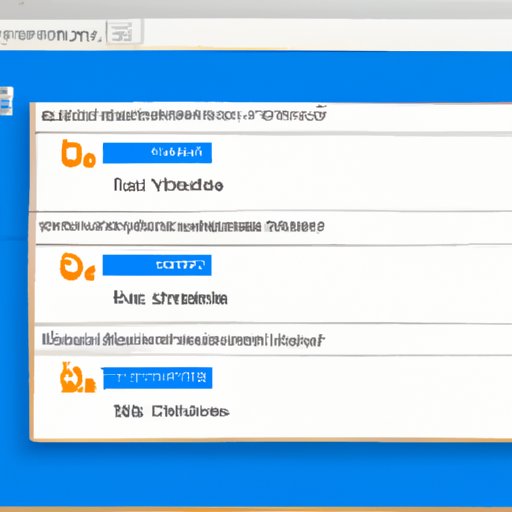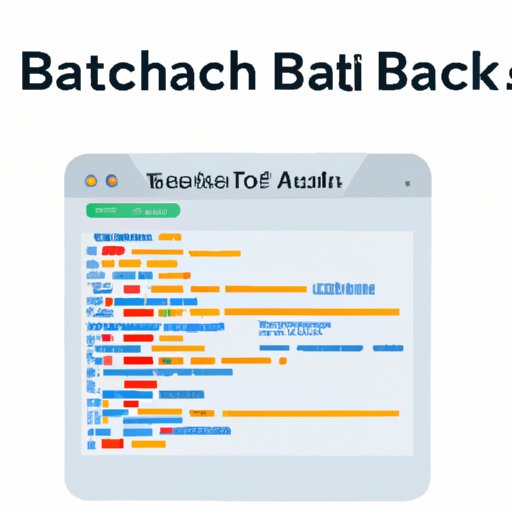Introduction
Task automation is a process of automating manual or repetitive tasks to save time and improve efficiency. Automation is becoming increasingly popular in the workplace. In fact, according to a survey by McKinsey & Company, 64% of companies reported that they are already using some form of automation. With Windows being the most widely used operating system in the world, it’s no surprise that many people are looking for ways to automate tasks in Windows.
In this article, we will explore the various ways to automate tasks in Windows, including using Windows Task Scheduler, setting up automation scripts with PowerShell, creating batch files, using the Windows command line, and exploring third-party automation tools. By the end of this article, you should have a better understanding of how to automate tasks in Windows.

Utilizing Windows Task Scheduler to Create Automated Tasks
Windows Task Scheduler is an application included in Windows that allows users to schedule tasks to be performed at specific times or intervals. It can be used to automate tasks such as running programs, opening files, or sending emails. It is a powerful tool that can help save time and increase productivity.
What is Windows Task Scheduler?
Windows Task Scheduler is a Windows utility that enables users to create automated tasks. It allows users to schedule tasks to run at certain times or intervals, and also provides other features such as the ability to trigger tasks based on system events and user logons. It is a useful tool for automating recurring tasks, such as running backups or defragmenting drives.
How to Create an Automated Task Using the Windows Task Scheduler
Creating an automated task using the Windows Task Scheduler is simple. First, open the Task Scheduler by typing “Task Scheduler” into the search bar. Then, select “Create Basic Task” from the Actions pane. This will open the “Create Basic Task Wizard”, which will guide you through the process of creating an automated task. You will need to provide a name for the task, a description, and the action that the task will perform.
Troubleshooting Common Issues with the Windows Task Scheduler
If you encounter any issues when using the Windows Task Scheduler, there are several troubleshooting steps you can take. First, make sure that the task is enabled. If it is disabled, simply right-click on the task and select “Enable”. You can also check the “History” tab to see if the task has run successfully. If the task is still not running, try restarting the Task Scheduler service. Finally, if all else fails, you can try reinstalling the Windows Task Scheduler.
Setting Up Automation Scripts with PowerShell
PowerShell is a scripting language developed by Microsoft that allows users to automate tasks in Windows. It is a powerful tool that can be used to automate repetitive tasks, as well as more complex tasks such as managing Windows services or managing Active Directory objects.
What is PowerShell?
PowerShell is a scripting language designed specifically for automating tasks in Windows. It is based on the .NET Framework, and is capable of performing a wide range of tasks, from managing Windows services to creating reports. It is a powerful tool that can be used to automate almost any task in Windows.
How to Create a PowerShell Script
Creating a PowerShell script is relatively easy. First, open the PowerShell ISE (Integrated Scripting Environment). This can be done by typing “powershell_ise” into the search bar. Once the ISE is open, you can begin writing your script. When you are finished, you can save the script as a .ps1 file and then execute it.
Common Problems and Solutions with PowerShell Scripts
When working with PowerShell scripts, it is important to be aware of common problems and solutions. One of the most common problems is syntax errors, which can be easily fixed by double-checking your code. Another common issue is permissions errors, which can be resolved by running the script as an administrator. Finally, if you are having trouble getting a script to run, you can try running the script in debug mode, which will allow you to step through the code line-by-line and identify any issues.

Creating Batch Files to Automate Tasks
Batch files are simple text files that contain a series of commands that can be executed in order to automate tasks. They are commonly used to automate simple tasks such as copying files, launching applications, or running scripts.
What are Batch Files?
Batch files are text files that contain a series of commands that can be executed in order to automate tasks. These files can be created using any text editor, such as Notepad. Batch files are commonly used to automate simple tasks such as copying files, launching applications, or running scripts.
How to Create a Batch File
Creating a batch file is simple. All you need to do is open a text editor, such as Notepad, and type in the commands you want to execute. Once you are finished, save the file with a .bat extension. You can then run the batch file by double-clicking on it.
Common Issues and Solutions with Batch Files
When working with batch files, you may encounter some common issues. One of the most common issues is syntax errors, which can be easily fixed by double-checking your code. Another issue is permissions errors, which can be resolved by running the batch file as an administrator. Finally, if you are having trouble getting a batch file to run, you can try running it in debug mode, which will allow you to step through the code line-by-line and identify any issues.

Using the Windows Command Line to Automate Repetitive Actions
The Windows command line is a powerful tool that can be used to automate repetitive actions. It allows users to execute commands quickly and efficiently, making it an ideal tool for automating tasks in Windows.
What is the Windows Command Line?
The Windows command line is a text-based interface that allows users to execute commands in order to perform tasks. It is similar to a shell in Unix-like operating systems, and is used to automate tasks in Windows. It is a powerful tool that can be used to perform a wide range of tasks, from managing files and folders to installing software.
How to Use the Windows Command Line to Automate Repetitive Actions
Using the Windows command line to automate repetitive actions is relatively straightforward. First, open the command prompt by typing “cmd” into the search bar. Then, type in the commands you want to execute. You can also use wildcards and variables to make the commands more efficient. Finally, if you want to execute a series of commands, you can use a batch file to automate the process.
Common Issues and Solutions with the Windows Command Line
When working with the Windows command line, you may encounter some common issues. One of the most common issues is syntax errors, which can be easily fixed by double-checking your code. Another issue is permissions errors, which can be resolved by running the command as an administrator. Finally, if you are having trouble getting a command to run, you can try running it in debug mode, which will allow you to step through the code line-by-line and identify any issues.
Exploring Third-Party Automation Tools for Windows
Third-party automation tools are software programs that can be used to automate tasks in Windows. These tools are often easier to use than the built-in Windows tools, and can be used to automate more complex tasks such as managing Windows services or managing Active Directory objects.
Overview of Third-Party Automation Tools
Third-party automation tools are software programs that can be used to automate tasks in Windows. These tools are often easier to use than the built-in Windows tools, and can be used to automate more complex tasks such as managing Windows services or managing Active Directory objects. Some popular third-party automation tools include AutoIt, WinAutomation, and AutoHotkey.
Pros and Cons of Third-Party Automation Tools
Third-party automation tools have both advantages and disadvantages. On the plus side, they are often easier to use than the built-in Windows tools, and can be used to automate more complex tasks. On the downside, they can be expensive, and may require additional training to use effectively.
Popular Third-Party Automation Tools for Windows
There are a number of popular third-party automation tools for Windows. Some of the most popular include AutoIt, WinAutomation, and AutoHotkey. Each of these tools has its own strengths and weaknesses, so it is important to research them before deciding which one is right for you.
Conclusion
Task automation is becoming increasingly popular in the workplace, and Windows is the most widely used operating system in the world. In this article, we have explored the various ways to automate tasks in Windows, from using Windows Task Scheduler and PowerShell scripts to creating batch files and exploring third-party automation tools. By following the steps outlined in this article, you should now have a better understanding of how to automate tasks in Windows.
Summary of Key Points
In this article, we explored the various ways to automate tasks in Windows, including using Windows Task Scheduler, setting up automation scripts with PowerShell, creating batch files, using the Windows command line, and exploring third-party automation tools. We also discussed common issues and solutions associated with each of these methods.
Final Thoughts on Automating Tasks in Windows
Task automation can be a great way to save time and increase productivity. With Windows being the most widely used operating system in the world, it’s no surprise that many people are looking for ways to automate tasks in Windows. In this article, we have explored the various ways to do so, from using Windows Task Scheduler and PowerShell scripts to creating batch files and exploring third-party automation tools. By following the steps outlined in this article, you should now have a better understanding of how to automate tasks in Windows.
(Note: Is this article not meeting your expectations? Do you have knowledge or insights to share? Unlock new opportunities and expand your reach by joining our authors team. Click Registration to join us and share your expertise with our readers.)
